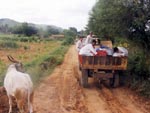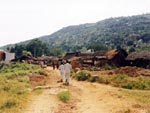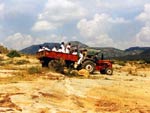|
 The
moment the word 'Go' was given, Swami's teachers and the students
swung into action. As always, very little time was available
to get organised; but then, in His typical fashion, Swami
made sure that everything went right, to drive home the point
[once more!] that He is the real doer. The
moment the word 'Go' was given, Swami's teachers and the students
swung into action. As always, very little time was available
to get organised; but then, in His typical fashion, Swami
made sure that everything went right, to drive home the point
[once more!] that He is the real doer.
Statistics on paper hardly reveal much, impressive
though they maybe. Yes, over two hundred villages and six
hundred hamlets had to be served. About half a million food
packets and laddus had to be distributed, and about a hundred
thousand pieces of cloth had to be given to the poor and destitute
in the villages. But how was one to get to these villages
in the first place, especially when were hardly any motorable
roads? How were estimates of the population in those villages
to be obtained when even Public Administration for villages
made ad hoc estimates? Where was the food to be cooked? Who
would do the packing and who would organise the distribution?
There were many pertinent and not so pliable puzzles But nobody
had any time even to think about these! There was no need
to either. They were all taken care of by the Master, as He
went about, executing His Master plan.
 Everything
got organised with lightning speed as always happens when
Swami runs the show. All questions suddenly stumbled upon
their answers, as if by magic! Collection of statistics, sorting
the clothes and readying them for distribution, the cooking,
and the packing - tough though all these were, they actually
formed the easy part. More difficult was the preparation of
maps [hardly anything existed to start with], route planning,
lining up the vehicles for distribution, and, above all the
logistic planning. Experts in Information Technology talk
of paperless office. Here was a massive project literally
done without any pieces of paper or memos sent from anyone
to anyone! The plain fact was that Swami gave absolutely no
time for all this. Everything
got organised with lightning speed as always happens when
Swami runs the show. All questions suddenly stumbled upon
their answers, as if by magic! Collection of statistics, sorting
the clothes and readying them for distribution, the cooking,
and the packing - tough though all these were, they actually
formed the easy part. More difficult was the preparation of
maps [hardly anything existed to start with], route planning,
lining up the vehicles for distribution, and, above all the
logistic planning. Experts in Information Technology talk
of paperless office. Here was a massive project literally
done without any pieces of paper or memos sent from anyone
to anyone! The plain fact was that Swami gave absolutely no
time for all this.
God's work is never easy, and what was feared
came true; there were no maps available to get to the villages!
So parties were hurriedly sent in advance to scout all the
areas to be covered, and monitor all the so-called roads/mud
tracks to be taken. Based on the information gathered, route
maps were hurriedly prepared and photocopies made. The volunteers
were organised into groups, each group servicing a set of
nearby villages. Team-leaders and co-ordinators were identified
by the senior teachers, and detailed briefing was given to
them every evening. Over a dozen trucks were commandeered
and a few tractor-trailers as well. Portable wireless sets
were procured and fitted to the trucks. In addition, several
people were given walkie-talkies so that they could communicate
with each other and also the mobile units. As if all this
was not enough, a control room was set up in Prasanthi Nilayam
and a mobile repeater wireless outpost was arranged to be
erected each day in one central location in the distribution
area to provide anchorage and communication assistance.
 The
action began on October 31th at the Pedda Venkama Raju Kalyana
Mandapam [the Paatha Mandiram of the pre-1950 days].It was
the first day of GRAMA SEVA. In keeping with the popular adage,
charity was to begin at home.Swami had decided that the Grama
Seva should be first done at Puttaparthi. In the morning,
after Swami came out for Darshan, all the boys and teachers
rose and went around the Mandir chanting Vedas and singing
Bhajans while Swami stood on the veranda smiling, watching,
and showering His Divine Grace. The procession streamed out
of the Sai Kulwant Hall to reassemble at the Kalyana Mandapam.
From there, all the teachers and students went in a procession,
singing Bhajans, to the Siva temple that now marks the birth
place of Swami. The procession then wound its way back to
the Kalyana Mandapam for the formal commencement of the distribution.
Meanwhile, Swami the ever-anxious Mother, came to the Kalyana
Mandapam to see if everything was alright - the human-aspect
of the Living God! The
action began on October 31th at the Pedda Venkama Raju Kalyana
Mandapam [the Paatha Mandiram of the pre-1950 days].It was
the first day of GRAMA SEVA. In keeping with the popular adage,
charity was to begin at home.Swami had decided that the Grama
Seva should be first done at Puttaparthi. In the morning,
after Swami came out for Darshan, all the boys and teachers
rose and went around the Mandir chanting Vedas and singing
Bhajans while Swami stood on the veranda smiling, watching,
and showering His Divine Grace. The procession streamed out
of the Sai Kulwant Hall to reassemble at the Kalyana Mandapam.
From there, all the teachers and students went in a procession,
singing Bhajans, to the Siva temple that now marks the birth
place of Swami. The procession then wound its way back to
the Kalyana Mandapam for the formal commencement of the distribution.
Meanwhile, Swami the ever-anxious Mother, came to the Kalyana
Mandapam to see if everything was alright - the human-aspect
of the Living God!
 The
compound of the Kalyana Mandapam was teeming with the poor
and the destitute of Puttaparthi, who were then given sweets,
food and clothes by the people assigned for duty there. Others
fanned out in various directions, moving through the town
distributing food and sweets from house to house, to each
and every member of the family, irrespective of whether the
persons were poor or rich. The students and teachers went
not only to the residences but also to the shops, telephone
booths, bus stand, street vendors, and the various hutment
colonies. No one was left out. Everywhere, with a smile, the
boys said, "Sai Ram. We are privileged to offer to you
these sweets and food which come with Love, Blessings and
the Grace of Bhagavan Baba." The
compound of the Kalyana Mandapam was teeming with the poor
and the destitute of Puttaparthi, who were then given sweets,
food and clothes by the people assigned for duty there. Others
fanned out in various directions, moving through the town
distributing food and sweets from house to house, to each
and every member of the family, irrespective of whether the
persons were poor or rich. The students and teachers went
not only to the residences but also to the shops, telephone
booths, bus stand, street vendors, and the various hutment
colonies. No one was left out. Everywhere, with a smile, the
boys said, "Sai Ram. We are privileged to offer to you
these sweets and food which come with Love, Blessings and
the Grace of Bhagavan Baba."
 For
everyone, it was a new experience, somewhat tiring but very
rewarding nevertheless. Swami came out early for Darshan that
afternoon. Some of the teachers and students had returned
but many were still to come back. Soon they also trudged in,
bushed, but beaming with satisfaction. But Swami was not very
happy. Why? Because many boys had not eaten lunch. They were
busy doing service, and after that rushed for Darshan. So,
we got strict instructions, "From tomorrow, all of you
will eat promptly at 11.30 A.M. No exceptions and no excuses.
You may suspend service for a while to have lunch. After eating,
you may resume service!" Words from a concerned Mother,
to Her children. For
everyone, it was a new experience, somewhat tiring but very
rewarding nevertheless. Swami came out early for Darshan that
afternoon. Some of the teachers and students had returned
but many were still to come back. Soon they also trudged in,
bushed, but beaming with satisfaction. But Swami was not very
happy. Why? Because many boys had not eaten lunch. They were
busy doing service, and after that rushed for Darshan. So,
we got strict instructions, "From tomorrow, all of you
will eat promptly at 11.30 A.M. No exceptions and no excuses.
You may suspend service for a while to have lunch. After eating,
you may resume service!" Words from a concerned Mother,
to Her children.
 Day
One was a mere curtain-raiser. After all, Puttaparthi was
home and there were no serious problems with roads, maps,
or even logistics. Day two would prove a lot tougher. And
so would every other day, as one went farther and farther,
into more remote villages. But it also promised to be more
exciting and challenging. Day
One was a mere curtain-raiser. After all, Puttaparthi was
home and there were no serious problems with roads, maps,
or even logistics. Day two would prove a lot tougher. And
so would every other day, as one went farther and farther,
into more remote villages. But it also promised to be more
exciting and challenging.
|